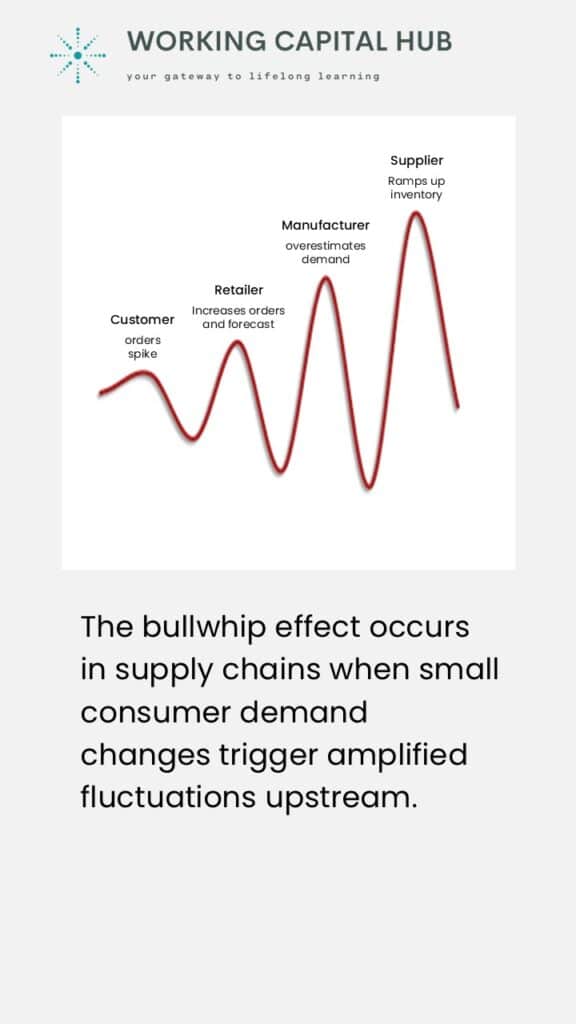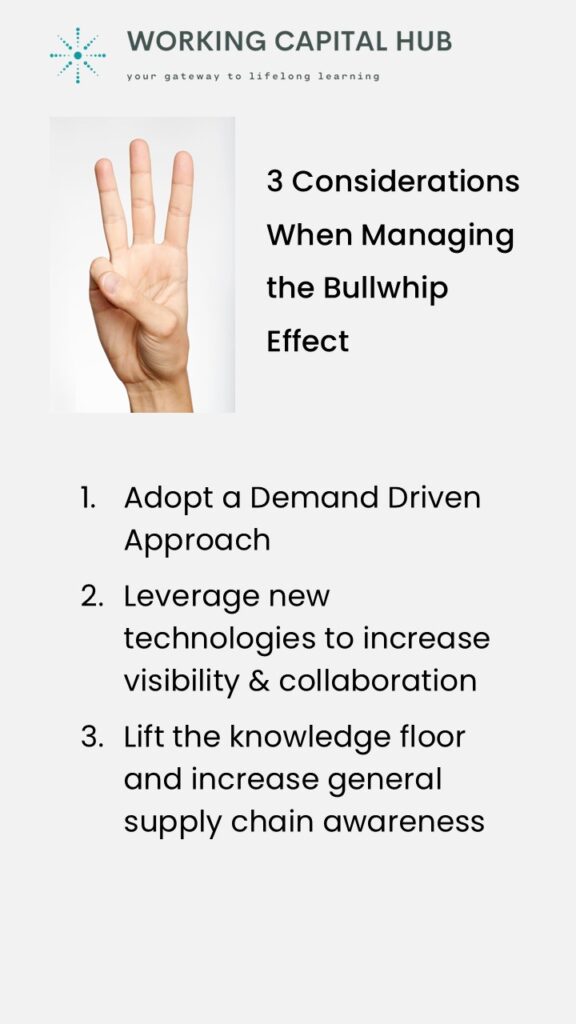
Taming the Bullwhip: 3 Key Strategies for Smarter Supply Chain Management
This article will explore the causes of the bullwhip effect: its impact on a company’s supply chain, operating working capital and cash conversion cycle.
By understanding these effects, businesses can improve coordination, enhance forecasting accuracy, and build a more agile, resilient supply chain.
The article will also cover 3 considerations companies should embrace, in order to successfully manage their supply chains.
Key Take Aways
- The Bullwhip Effect: Small changes in consumer demand can lead to amplified fluctuations along the supply chain. This cause inefficiencies, higher costs, and poor supplier/customer relationships.
- Causes of the Bullwhip Effect. Inaccurate demand forecasting, order batching, lead time variability, pricing promotions, and rationing/shortage gaming are primary contributors.
- Increase Visibility and Collaboration. Foster trust and transparency across stakeholders by sharing inventory data, improving communication, and implementing tools like vendor-managed inventory (VMI).
- Leverage Technology. Invest in supply chain systems for real-time visibility, scenario planning, and improved data sharing with external partners to address distorted demand signals proactively.
- Boost Supply Chain Knowledge. Educate employees on the bullwhip effect. Build a shared understanding of your organization’s optimal supply chain to enable informed decision-making.
- Embrace Agility. Adapt to changing demand patterns by shortening lead times, streamlining logistics, strengthening supplier relationships, and maintaining optimal inventory levels.
“The bullwhip effect refers to a scenario in which small changes in at the retail end of the become amplified when moving up the supply chain from the retail end to the manufacturing end“
Investopedia
Want to own this article? Download it for free at MyAcademyHub.com
What is the Bullwhip Effect?
The bullwhip effect is a phenomenon observed in supply chain management where small fluctuations in demand for a product at the consumer level can result in amplified fluctuations in demand along the supply chain.
This effect causes variability in order quantities and inventory levels to increase as one moves upstream in the supply chain, from the end consumer to the raw material supplier.
Several factors contribute to the bullwhip effect, including:
- Demand Forecasting. Inaccurate demand forecasting, either due to lack of information or forecasting errors, can lead to overordering or underordering of goods.
- Order Batching. Businesses tend to consolidate orders to take advantage of economies of scale or to minimize transaction costs. This can lead to irregular ordering patterns and exacerbate demand variability.
- Lead Time Variability. Variations in lead times for ordering and delivery can amplify the bullwhip effect. Longer lead times can result in larger order quantities as companies try to hedge against uncertainties.
- Pricing and Promotions. Price discounts, promotions, or incentives can lead to sudden spikes in demand followed by periods of low demand, further amplifying the variability in orders.
- Rationing and Shortage Gaming. In situations of shortage, customers may inflate their orders in anticipation of future shortages, leading to increased demand variability.
The bullwhip effect can have detrimental effects on supply chain efficiency, leading to increased inventory costs, stockouts, and reduced customer satisfaction.
Managing the bullwhip effect requires improved communication and coordination among supply chain partners, better demand forecasting techniques, and strategies to reduce lead time variability.

Example of the Bullwhip Effect
Imagine a retailer notices an increase in demand for bottled water due to a heatwave.
- Consumer Level: Customers buy more bottled water, and shelves start to empty. The retailer responds by increasing its order from the distributor to restock quickly.
- Retailer Level: Seeing the spike in orders, the retailer assumes that future demand will remain high. To avoid running out of stock, the retailer places a significantly larger order with the manufacturer.
- Manufacturer Level: The manufacturer observes the surge in orders and scales up production, overestimating the long-term demand. To prepare for even higher future orders, they procure extra raw materials from their suppliers.
- Supplier Level: The raw material supplier, noticing increased orders from the manufacturer, ramps up their production and inventory, assuming the demand will persist.
By the time the heatwave ends and consumer demand returns to normal, there is a surplus of bottled water at the retailer, distributor, manufacturer and supplier level.
This surplus in turn leads to increased holding costs, waste, and inefficiencies at every level of the supply chain.
This example demonstrates how a small increase in consumer demand can cascade into exaggerated production and ordering upstream, highlighting the bullwhip effect.

3 Considerations When Managing The Bullwhip Effect
A typical supply chain has several layers of stakeholders: from suppliers of raw material to manufacturers, distributors, retailers and finally the end customer. The intricate balance of supply and demand across these stakeholders relies on accurate two-way communication.
As mentioned, the bullwhip effect happens when distorted demand signals oscillates back throughout the chain, often amplified at every stage, leading to a multitude of negative consequences. These include: unfounded build-up or ramp-down of capacity and stock, inefficient and costly production, damaged supplier/customer relations, lost revenues, and more…
Be ready for a future with an increased frequency in changes to demand patterns. These will not only be driven by pandemics and global crisis, but also new technologies and disrupting business models.
Be ready to shorten your planning and execution lead-times. Supply chain agility will be key to excel in this new reality. Streamline your logistics and supply chain footprint. Improve your supplier relationships to allow for smaller and more frequent deliveries.
And constantly monitor your inventories and safety stock levels to ensure right amounts of the right things at the right time.
However, even if increased agility will dampen the effects from shifting demand, companies should also improve their ability to identify and pro-actively avoid future bullwhips:
1. Adopt a Demand Driven Approach
- Transition towards a balanced demand-driven and Just-in-Time (JIT) supply chain management strategy, where stable products are pushed and volatile demand items are pulled.
- Give your organization the tools to differentiate between short-term variability and long-term changes to market demand.
- Leverage demand-sensing, forecasting, and inventory optimization software to improve accuracy and real-time visibility. Adopt technologies like predictive analytics, artificial intelligence (AI), and IoT connectivity for better decision-making.
- Work to minimize future bullwhip effects through improved communication and frequent information sharing across your supply chain, as part of a robust Sales and Operations Planning (S&OP) or Integrated Business Planning (IBP) process. Trust is key.
- Take detailed stock of not only your own inventory, but also your customers’ inventories. Many companies don’t realize what the inventory of their customers looks like, making it difficult to differentiate between true demand versus re-stocking activities.
- Encourage your larger customers to share information, or even install vendor managed inventories (VMI) of your standard items
2. Leverage new technologies to increase visibility & collaboration
- Embrace digital technologies to enhance visibility across the end-to-end supply chain, including external stakeholders.
- Improve data sharing with your supply chain partners to ensure real time updates on stock availability and upcoming demand. Use tools like supplier portals, Electronic Data Interchange (EDI), and supply chain management software to enhance collaboration.
- Companies who invest in good supply chain systems, with the ability to plan and replan based on multiple scenario outcomes, will ultimately manage better than those who will not.
- The ability to pro-actively identify and deal with distorted demand signals will be key going forward – requiring improved real-time data handling and visualization, as well as the ability to simulate multiple outcomes.
- Transparency ensures all stakeholders – from suppliers to end customers – have the information needed to prevent overproduction, stockouts, and excess inventory.
3. Lift the Knowledge Floor
- The first step in avoiding future bullwhip effects is making sure as many people as possible understand what causes them.
- Even though the automation and digitalization of things will increase, human intelligence and experience cannot be fully replaced (yet!). Data is not enough, someone must be there to interpret, communicate and act on its meaning.
- Lifting the knowledge roof is not enough, we also need to activate and lift the knowledge floor – creating a common platform of understanding across the organization in how your version of an optimal supply chain should operate.
Eager to learn more? Check out our accredited e-learning course Managing Working Capital


Leave a Reply